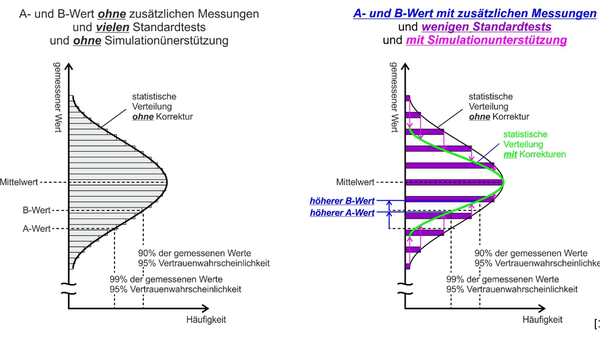Strength parameters used for design with and without additional measurements

Fiber-reinforced composites, and in particular carbon fiber reinforced plastics (CFRP), are used in many products across all industries for lightweight construction. Due to various influencing factors, the determination of material properties required for design shows relatively high scatter. These scatters lead to comparatively higher reductions in the reduced strength values used for design (A and B values, see Fig. 1).
Consequently, components have to be dimensioned larger, which leads to an increased use of resources and thus also to higher CO2 emissions. There is therefore considerable potential for savings in this area, which gives rise to the topic of the project:
Reduction of CO2 emissions by increasing material utilization with the help of the 3D digital twin.
The aim of the project is to gain a better understanding of the scattering of the mechanical properties of fiber composites by using simulation tools and material analysis. By identifying critical influencing factors and digitally mapping the development process, these scatters are to be reduced. The use of digital twins allows the results to be used throughout the life of the product. This approach leads to the following effects:
The project consortium has been put together in such a way that all relevant aspects of the development process are covered by experienced partners. This includes the production of the material components (matrix systems, fibers), specimen production and testing, numerical calculation with micro- and macromechanical modeling approaches, as well as the scientific investigation of corresponding mechanical test procedures (see Fig.2).
Modified standard tests
Testing and material characterization
Simulation
In the RICA project, new methods were developed to describe the behavior of composites more precisely. In particular, the consistent use of digital image correlation was employed to generate strain fields in all three directions (including out-of-plane) and to obtain stress-strain curves up to specimen failure. The characteristic values determined in different test methods and complete stress-strain curves can thereby be used to more accurately represent material behavior in simulations.
Especially in the characterization of anisotropic materials, a more comprehensive determination of material properties in all directions can lead to a better understanding of the material behavior and a more accurate representation in simulations.
Data acquisition using DIC also allows the respective clamping effects of standard and modified test fixtures to be considered and analyzed in more detail and thus load introductions to be optimized.
Project duration: December 2020 to November 2023
The project is funded by the German Federal Ministry of Economics and Climate Protection (BMWK) as part of the Technology Transfer Program Lightweight Construction (TTP-LB).